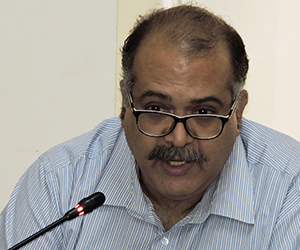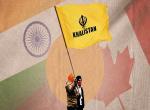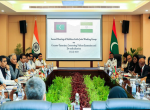The resistance by powerful Afghan Taliban leaders and field commanders to the nomination of Mullah Akhtar Mansoor as successor of Mullah Mohammad Omar and his elevation as the new Emir of the Taliban movement has, for now at least, spoiled the elaborate end-game that the Pakistanis had planned in Afghanistan. The talks between the Afghan Taliban and the Afghan government have been put on hold and there is no clarity if they will re-start anytime soon, if at all. And even if they do re-start, there are doubts whether these talks will be able to deliver anything close to peace.
One big reason for that is that a large section of Afghan Taliban don’t trust the Pakistanis who have been trying to broker or, if you will, ‘facilitate’, the talks between the Taliban and the Afghan government. They fear that the Pakistanis will leave them out in the cold. This, despite the fact that Pakistan has given support and sanctuary to the Taliban in their fight against the American-led foreign forces which were backing the Afghan government since November 2001. What the Taliban really think of the Pakistanis was summed up by Mullah Abdul Salam Zaeef, the last Taliban ambassador in Islamabad who was unceremoniously and against all diplomatic norms arrested and handed over to the Americans after 9/11. In his autobiography, Mullah Zaeef writes: “Pakistan…is so famous for treachery that it is said they can get milk from a bull. They have two tongues in one mouth, and two faces on one head so they can speak everyone’s language; they use everybody, deceive everybody. They deceive the Arabs under the guise of Islamic nuclear power, saying they are defending Islam and Islamic countries. They milk America and Europe in the alliance against terrorism, and they have been deceiving Pakistani and other Muslims around the world in the name of the Kashmir Jihad. But behind the curtains they have been betraying everyone.”
Until the ‘premature’ announcement that Mullah Omar had died over two years ago in 2013 – it is not even clear if he was alive till then because for many years now there was no real proof of life about him – it seemed that the Pakistani-owned, Pakistani-led peace process which donned an Afghan mask was going according to plan. Come to think of it, Mullah Omar had to die and be replaced by a pliable Pakistani lackey for the Pakistani end-game plan to succeed, and Mullah Akhtar Mansoor is just that person. If the revelation of Mullah Omar’s death – a closely guarded secret for at least two years now – had not been made at this rather inopportune (not just for the successor but also his masters in ISI HQs) time, it would have been made after a couple of months when the deal that the Pakistanis were brokering had been stitched together.
The bottom-line is Mullah Omar had lost his relevance for Pakistan. Given Mullah Omar’s stature and position, not just among the Afghan Taliban but also in the larger Jihadist pantheon, there was practically no possibility of any compromise formula, much less any peace deal, as long as he was alive. After all, how could an Emir-ul-Momineen agree to an elected (and one uses the word advisedly given the manner in which Ashraf Ghani was ‘elected’) President and head of state. What is more, even if Mullah Omar had been alive and had rooted in favour of a negotiated settlement – the grapevine is that he remained implacably opposed to talks with the Afghan government – chances are that his more radical and hard line followers would have repudiated him and rebelled against him. Ironically enough, if, as is being suspected and even alleged, that Mullah Omar was bumped off by Mansoor and rest of his Pakistani-inspired and Pakistani controlled coterie, then it seems that the Emir-ul-Momineen had outlived his usefulness for both the hardliners as well as those who were ready to a negotiated deal.
The premature release of the news of Mullah Omar’s death is clearly part of the power struggle in the Taliban and the growing disquiet among the fighters over the so-called peace process. Assuming that Omar died in 2013, the fact that those opposed to peace talks did not insist on proof of life for all this time was because there was really no change on the ground in terms of strategy. The Pakistani policy during this period was two-pronged: keep speaking in favour of an “Afghan-led, Afghan-owned” peace process and at the same time keep encouraging the Taliban fighters to continue, and even intensify, their attacks inside Afghanistan. This suited the hardliners, more so because the various track-II dialogues around the world – in some of them the so-called Taliban representatives with Pakistani Afghan agents – didn’t seem to be going anywhere anyway. In other words, keeping Mullah Omar ‘alive’, as it were, suited the hardliners and also those who were ready to toe the Pakistani line and explore the possibility of a negotiated settlement.
But the Murree talks, followed by the so-called Eid message which, as it now turns out, was issued by Mullah Omar from his grave, set alarm bells ringing. The first indication of something not being right came some months back when a Pakistani Taliban group denounced the Afghan Taliban as Pakistani agents and broke their ties with them. The bee-line that some Taliban groups made for joining the Islamic State also suggested that all was not well. The impression got strengthened when the Taliban, out of the blue, issued a bio-data of Mullah Omar in April. After the Murree talks, a breakaway Taliban group, Fidayee Mahaz, first revealed that Mullah Omar had been killed by Masoor and his sidekicks. Intimations of Mullah Omar’s death had been doing the rounds for some time. Questions had been raised even last year over whether he was even alive. But these were invariably brushed under the proverbial carpet. This time, however, many Taliban leaders demanded proof of life especially since they smelled a rat after Mullah Omar supposedly endorsed the Murree peace talks.
In a sense, the Pakistani hand was forced by its own double-game of reaching out to the new Afghan government even as it gave a free hand to the Taliban to ratchet up the pressure through attacks inside Afghanistan. The growing resentment inside Afghanistan over the attacks put pressure on Ashraf Ghani to demand that Pakistan keep its side of the bargain, which was to ‘facilitate’ direct talks between the Taliban and the Afghan government. The Pakistanis organised the Murree talks but soon doubts were raised whether these had the nod of the Taliban leadership. Even earlier, questions were raised about the so-called Taliban representatives who went for track-II meetings and who were seen more as ISI representatives rather than Taliban representatives. Pakistan was therefore forced to issue a statement in Mullah Omar’s name. Since the dead Emir-ul-Momineen often used to issue messages on the occasion of Eid, it seemed appropriate to have him issue another message, even if this one was from his grave.
Unfortunately for Pakistan, the message seemed as though it was drafted in Aabpara (ISI HQ) – its basic message had striking resemblance to the speech made by Musharraf justifying his U-turn after 9/11. The hardliners were spooked by the message and their distrust of Pakistan and their fear that Pakistan will once again double-deal and leave them in the cold appeared to come true. The Pakistanis themselves had declared in official statements that the peace talks would isolate the hotheads among the Taliban, who could then be dealt with separately. Reports that Pakistan was ready to act as a guarantor for the Afghan government giving the Taliban a share in the power in Kabul only confirmed the apprehensions that Pakistan was all set to leave the recalcitrant fighters out in the cold.
While on paper isolating the militants sounded like a good strategy, the problem was that unless the people fighting on the ground were brought in, peace in Afghanistan would remain illusory. The Pakistanis figured that they would be able to rein in the Taliban holdouts using the firepower of the ‘veritable arm of the ISI’ i.e. Haqqani Network which had been kept in reserve to tilt the battlefield Pakistan's way. No surprise then that as soon as Mansoor was declared Emir, he appointed the Haqqani Network’s de facto chief, Sirajuddin Haqqani, as his deputy and head of the military council. In a sense then the Mansoor Taliban is really an extension of the Haqqani Network (which is going to be the power behind the throne) which in turn is an instrument of the ISI. And if all goes well, with Ashraf Ghani ready to dance to Pakistani tunes and with Haqqani Network becoming part of the Afghan government, Pakistan is all set to see the fruition of its strategic policy.
The leaking out of Mullah Omar’s death has however put a spanner in the works of the “Pakistan-owned, Pakistan-led” peace process. The whole situation is now in a flux. There are broadly four possible outcomes:
- The Pakistanis manage to ensure Mansoor’s survival. The hardliners either fall in line or are eliminated through joint action of the Afghan National Army and the Mansoor Taliban. Already there are reports of some of the big commanders who were earlier opposing Mansoor, falling in line. Others are reported to have been arrested and put away. There are also rumours that the man who could become the lightening rod for the anti-Mansoor Taliban, Mullah Omar’s son Yakub, has been killed and Omar’s family taken away to some unknown place – remarkable resemblance to the treatment meted out to the family of Prophet Mohammad! Once opposition is eliminated, the Pakistani strategy of cobbling together a peace deal which gives the Taliban a big share in the power structure in Kabul will be put in place. The anti-Taliban Afghans will make some noise and show some resistance, but they will either be bought over or bludgeoned into accepting the new reality.
- All the shenanigans to project Mansoor as the leader come a cropper and the resistance to Mansoor mounts. If things start going out of control, Pakistan could sacrifice Mansoor and let the Haqqani’s throw their weight behind the hard line faction and then try to regain its influence over the new leadership. This would mean that the current peace process will become history and Afghanistan will undergo a fresh paroxysm of violence.
- The division between the pro and anti-Pakistan Taliban is not bridged and there is a new realignment of forces. The anti-Pakistan, anti-Ashraf-Ghani forces in Afghanistan make common cause with the anti-Pakistan, anti-Afghan government and anti-Mansoor Taliban and fight the Pakistani proxies. This is a bit of a long shot but stranger things are known to have happened in Afghanistan where loyalties are fungible and all alliances and enmities temporary and transient. But this scenario again means a civil war in Afghanistan, fuelled by countries which back one or the other group.
- The last scenario is a sort of multi-pronged civil war in which the protagonists are the Afghan government and perhaps the Mansoor Taliban backed by Pakistan on one side, the anti-Ashraf Ghani and anti-Taliban Afghans holding a second front, and the anti-Afghan government, anti-Pakistan, and anti-Mansoor Taliban forming a third front. In this there is also the possibility of a new actor coming into play – the Islamic State. Needless to say, this is the worst nightmare for all players in Afghanistan.
By all accounts then, a dead Mullah Omar is just as bad news as a living Mullah Omar and the future of Afghanistan is very delicately poised. The biggest problem, and the biggest mistake, is that there is never an end-game in Afghanistan. Whenever countries and players prepare for an endgame, they only end up planting the seeds of a new Great Game. Post Mullah Omar, the old end-game is all but over and the new Great Game is starting to unfold.
Published Date: 5th August 2015, Image Source: https://www.dailystar.com.lb\
(Disclaimer: The views and opinions expressed in this article are those of the author and do not necessarily reflect the official policy or position of the Vivekananda International Foundation)










Post new comment